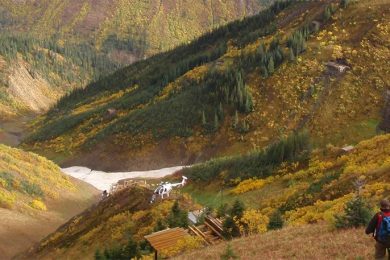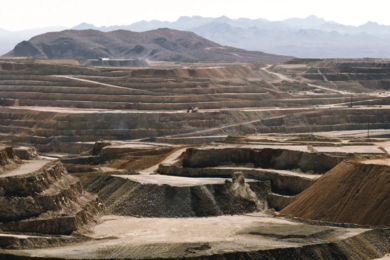The latest issue of International Mining Project News from July 22 once again highlights the scramble for materials feeding the electronics boom, from lithium to tin to graphite. The challenge for juniors will be reaching production while there is still a supply/demand gap, and making sure sizeable offtake agreements are in place. Gold activity remains strong with the gold prices further boosted by economic uncertainty. Contact [email protected] for subscription details and news of the half price deal to attend on of Whittle Consulting’s MONEY MINING & SUSTAINABILITY SEMINARS around the world.
In pre-feasibility, European Metals Holdings provides an update to the progress of the current PFS on the Cinovec lithium-tin project. This PFS is targeting an initial production rate of 20,000 t/y of lithium carbonate with associated tin, tungsten and sulphate of potash credits. As part of the PFS, various trade-off studies have been completed on the underground mine design. The major focus has been on decreasing required capital and maximising cashflow in the first five years of the mine life. As a result, a revised mine plan has been designed to access the high grade lithium areas of the orebody that lie close to surface.
ATAC Resources Ltd has filed a positive PEA for the Tiger deposit located at the western end of its 100% owned Rackla gold project in the Yukon. Recent work on the 1,700 km2 project has resulted in a positive PEA for the Tiger gold deposit, drilling of multiple high-grade Carlin-type gold zones and the identification of numerous early-stage gold exploration targets. At the Koala gold mine, part of the Mt Coolon gold project, Queensland. GBM Resources has announced a remodelled resource estimate at which has resulted in a significant 135% increase to 1.4 Mt averaging 2.6 g/t Au:
In copper, Stavely Minerals is to assess potential low-cost copper production with scoping study at Thursday’s Gossan. Conceptual study demonstrates positive economic outcome and acceptable rate of return on investment at realistically assumed costs and commodity/currency pricing with a number of areas identified to potentially improve the projected economic outcomes.
Elsewhere in the world there are still interesting developments in bulk commodities. Kibo Mining plc, the Tanzania focussed mineral exploration and development company, has the completed Mining Definitive Feasibility Study (MDFS) of the Mbeya Coal to Power Project (MCPP). The MDFS comprised the optimisation of the mine design, a detailed mine design based on the results from the restated Mbeya Coal Resource and the final coal requirement for the Mbeya power station as stated in the Power Definitive Feasibility Study (PDFS). Results from the MDFS correlate accurately with those of the prefeasibility study (MPFS) and have reconfirmed the Mbeya coal mine as a robust project with strong financial and commercial indicators. The MDFS mining method made it possible to design a power station that required significantly less coal for the same output i.e. 1,840 GWh/y. Although this will result in a linear reduction of revenue for the coal mine, this is more than recovered in cost savings for the power plant which is most sensitive to fuel costs.
Joint venturers Neometals Ltd and Mineral Resources Ltd have taken a major step towards commercialisation of their patented ELi Process that could see low cost battery grade lithium products produced from spodumene concentrate sourced from the Mt Marion project near Kalgoorlie. Results of a feasibility study, following a positive prefeasibility study in 2012, have confirmed the proposed production project is technically feasible and economically viable. The ELi Process converts spodumene concentrate into a high purity lithium chloride solution, then uses electrolysis to produce high purity lithium hydroxide and lithium carbonate, both high value products used in the lithium ion battery industry.
In uranium, Berkeley Energia reports an independent study has confirmed the Salamanca project as one of the world’s lowest cost producers capable of generating strong after tax cash flow through the current low point in the uranium price cycle. A DFS has reported that over an initial ten year period the project is capable of producing an average of 4.4 Mlb/y of uranium at a cash cost of $13.30/lb and at a total cash cost of $15.06/lb which compares with the current spot price of $26/lb and term contract price of $41/lb.
Moving to projects in development, Nemaska Lithium has completed its previously announced public offering for aggregate gross proceeds of C$69,000,115. It intends to use the net proceeds of the Offering for engineering fees in relation to the Whabouchi mine and concentrator and the Shawinigan hydromet plant, down-payments for long lead items, drilling and for general working capital purposes. Guy Bourassa, President and CEO of Nemaska Lithium: “This financing strengthens Nemaska Lithium from a project execution standpoint, as we can now progress the commercial mine and hydromet plant projects in a significant way.”
Private explorer and developer, Australian Tin Resources, is progressing a proposal to build a pilot plant at its Ardlethan tin project in New South Wales for the reprocessing of historical tailings stockpiles at the site, ITRI reports. Inferred and Indicated resources of all tailings totals 10.73 Mt at 0.20% Sn. Bulk testing of the material was followed by a scoping study for implementation of a 15-30 t/h modular pilot plant using simple gravity processing methods, with potential to be scaled up to 120 t/h. A commercial contract for construction of the plant is currently under negotiation.
Galane Gold Ltd has approved a $2.0 million capital expenditure program required for the first phase of the recommencement of production at its Galaxy gold mine in South Africa, up to a target of 60,000 oz/y. The company anticipates that the first phase will take six months to complete and it will be funded from internal cash flows primarily from the company’s core operation in Botswana.
Avenira Ltd has announced that Gadde Bissik Phosphates Operations SUARL, a Senegalese subsidiary of Avenira, has signed its first export rock phosphate supply agreements with established international fertiliser companies, with Baobab rock phosphate product destined for downstream phosphate fertiliser producers. These agreements mark a significant milestone for Avenira as the company approaches first production at Baobab.
Projects reporting on early production include Peninsula Energy Ltd which provided an update on production and ramp-up at the Lance projects in Wyoming, USA. During the quarter ended 30 June 2016, 28,858 lb U3O8 were extracted from the Lance projects, an increase of almost 20,000 lb U3O8 over the quarter ended 31 March 2016.
Pre-commercial production has commenced at Golden Star Resources’ Wassa underground mine in Ghana, as scheduled. The successful blasting of the first stope in the F Shoot of Wassa Underground took place on July 10, delivering the first ore from the new underground mine to the Wassa processing plant.
Pan American Silver Corp has achieved a significant milestone in the expansion of its La Colorada mine in Mexico, with the successful commissioning of the new sulphide ore processing plant. The new plant began processing sulphide ore on July 1, 2016, achieving production throughput rates of over 1,400 t/d and over 14,000 t treated by July 10. Throughput rates will be slightly reduced until the mine shaft and additional underground development have been completed to provide higher ore supply.
NSL Consolidated Ltd has announced that the company has secured commitments predominately from, investment funds and high net worth investors for the placement of 170,000,000 fully paid shares at an issue price of $0.02 cent per share, raising $3,400,000 before costs of the offer. The company is the only Australian or foreign company to own and operate in India’s massive iron ore market, has an established dry processing plant operation for iron ore product at Kurnool and which is serviced by two of its local mines nearby, Kuja and Mangal. These mines will also provide the feedstock for the Phase Two wet beneficiation plant.










